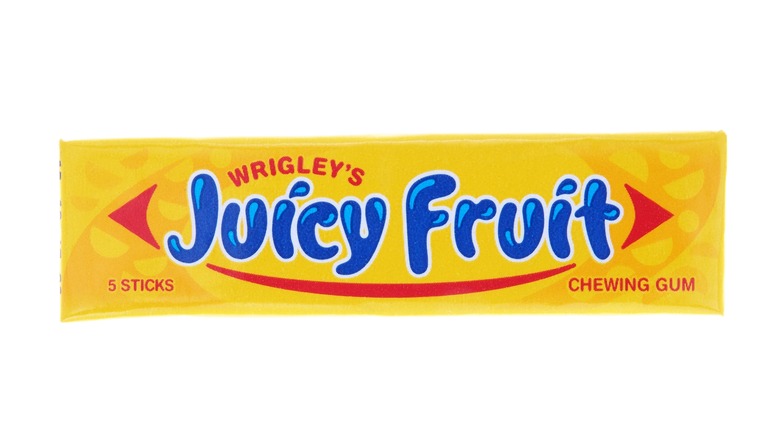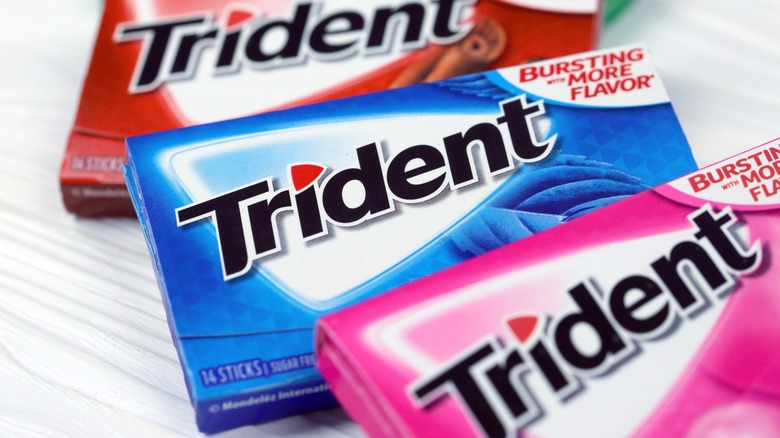The Fascinating Reason Why Chewing Gum Doesn't Need An Expiration Date
Chewing gum has existed in the world for over 9,000 years, per History, though not necessarily in the same form as a stick of Wrigley's or a piece of Dubble Bubble. The reasons for its use have varied with time and from culture to culture — ranging from quenching thirst and quelling hunger to soothing toothaches — but its existence has nonetheless persisted. These days, the modern-day chewing gum you see displayed near the cash register at your local bodega or gas station has taken on a whole new persona as candy. Millions of Americans rely on the chewy substance to pass the time, freshen their breath, or indulge in a rush of sugary sweetness, per Statista.
While you might be pretty familiar with opening up a pack of Trident or Hubba Bubba by now, there might actually be one thing that you've never noticed about your typical pack. Unlike the vast majority of other foods out there, chewing gum has no expiration date. This may come as a shock to many, but there's actually a fascinating reason behind this. Before we jump into why, let's delve into chewing gum's ancient origins.
The origin story of chewing gum
To backtrack to before chewing gum made waves commercially, the substance was alive and well in ancient cultures. The Mayans and the Aztecs relied on chewing resin to freshen their breath and to quench thirst, and even the ancient Greeks chewed on a plant substance called mastich per Smithsonian magazine.
According to History, the first commercial pack of gum popped up in the late 1840s when businessman John Curtis boiled resin, cut it into strips, and coated them in cornstarch. But this was hardly Curtis' original idea: This recipe for the first-ever spruce tree gum was an idea that actually came from the indigenous people of North America, who chewed spruce tree resin.
Shortly after making his first batch of the stuff, Curtis opened the first chewing gum factory in Maine — but the man that truly popularized chewing gum, however, was William Wrigley, per History. This savvy businessman started out his career by selling soaps, and as an incentive for stores to carry his products, he began to supply free chewing gum with all the orders. After the success of the sales Wrigley created new brands of chewing gum in 1893: Juicy Fruit and Wrigley's Spearmint. He poured heavily into marketing, even mailing free packs of his gum to strangers from the phonebook. Slowly, more and more people started to chew gum and competition grew. But even back then, no expiration date was needed.
How is it possible that chewing gum never expires?
While gum has gone through many different phases in its history, it now remains one of the best treats to use to freshen your breath, or even just to cure boredom. But one of the absolute best things about these treats is that they never go bad. Even if you find a pack in the bottom of your purse that you're pretty sure you bought three years ago, there's no need to sweat it.
So how is that possible? According to Joan Mestres, co-author of the book "Formulation and Production of Chewing and Bubble Gum", that's because gum is made mostly of plastic (via Serious Eats). The base of most modern chewing gums are synthetic, chewy resins, soft waxes, and something called " elastomers" that make the gum stretchy. Per The International Chewing Gum Association, these ingredients mean gum has almost no moisture content and thus is not required to have an expiration date. But while gum never fully goes bad per se, it can lose some of its quality and become hardened. Still, it should always remain safe to chew. (Although to be fair, this also might be one of the reasons why you shouldn't swallow gum – or rather, one of the reasons you might want to avoid it, at any rate.)


